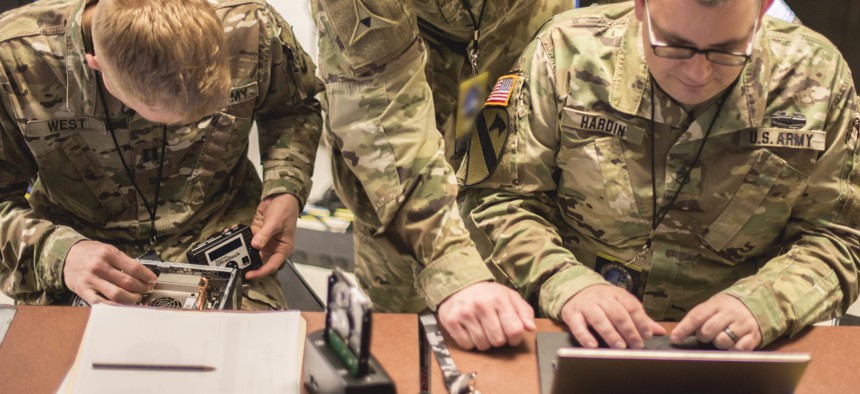
Members of the Illinois National Guard practice digital forensic skillsets during a Cyber Shield 19 training week class at Camp Atterbury, Ind. April 7, 2019. U.S. Army National Guard / Staff Sgt. George B. Davis
The US Army Is Struggling to Staff Its Cyber Units: GAO
Congress' watchdog concluded that the Army launched its new cyber units before trying to determine whether the concept is affordable, supportable, and sustainable.
The U.S. Army is struggling to staff, train, and equip its new cyber and electronic warfare units, and officials haven’t assessed how those challenges will affect the Pentagon’s digital capabilities, according to a congressional watchdog.
In recent years, the Army has been rapidly expanding its cyber capabilities to stay ahead of the growing digital threats posed by adversaries like Russia and China, but the Government Accountability Office found the service is having a tough time keeping up with its ambitious plans. The Army activated two digital warfare units last year despite personnel shortages, auditors said, and officials are struggling to update the equipment and doctrine used to train soldiers.
Furthermore, the Army hasn’t conducted thorough risk assessments for its new units, which could make it harder for top brass to keep the forces running at full capacity in the long term, GAO said in a report published Thursday.
While Army officials said the digital threats posed by Russia and other adversaries justify the accelerated deployment process, auditors said the hasty plan could leave the Army “fielding units that are not capable of providing the needed capabilities.”
Related: Welcome to Tatooine, the US Army’s Newest Cyber Training Space
Related: Pentagon’s Cyber Mission Force Needs Better Training Plan
Related: The US Needs a Cybersecurity Civilian Corps
Army officials told GAO they’re struggling to recruit personnel to fill their new cyber units, particularly for high-level positions. Last year, officials stood up two cyber units with numerous vacancies—one unit had only 55% of its posts filled as of March, while the other was operating with less than 20% of its required personnel. According to auditors, the Army is considering increasing pay and offering retention bonuses to make the positions more attractive.
The accelerated activation process has also left the Army scrambling to equip its cyber forces, auditors said. The problem is even more prevalent in the Army Cyber School because officials are diverting resources away from trainees toward its operational units.
“If the Army does not acquire new equipment quickly enough, the result could be that soldiers in the Army Cyber School will be trained on outdated equipment, which they will not use when they get to the field,” GAO said. And because the Army is still finalizing its doctrine for cyber units, instructors said they may soon have “difficulty designing training for the new units, and soldiers will not have a clear understanding of their tasks and missions.”
Army officials are also required to conduct a risk assessment whenever they activate a new unit, but GAO found the branch hasn’t completed those evaluations for its new cyber squads. Such assessments inform the Army’s future readiness planning, and without them, “leaders may be left with an incomplete picture of the challenges in affording, supporting, and sustaining these units over the long term,” auditors said.
GAO recommended the Army complete risk assessments for the two cyber units it activated last year—the Intelligence, Cyber, Electronic Warfare, and Space unit and the 915th Cyber Warfare Support Battalion—and examine the risk of its accelerated activation strategy.




